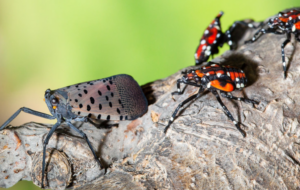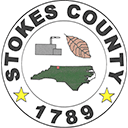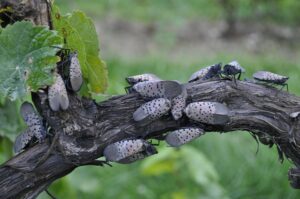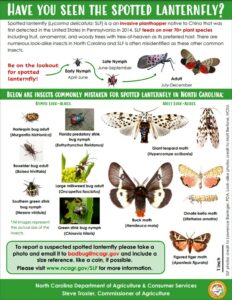A Warning From the NC Dept. of Agriculture, Plant Industry Division – Spotted Lanternfly
go.ncsu.edu/readext?830184
en Español / em Português
El inglés es el idioma de control de esta página. En la medida en que haya algún conflicto entre la traducción al inglés y la traducción, el inglés prevalece.
Al hacer clic en el enlace de traducción se activa un servicio de traducción gratuito para convertir la página al español. Al igual que con cualquier traducción por Internet, la conversión no es sensible al contexto y puede que no traduzca el texto en su significado original. NC State Extension no garantiza la exactitud del texto traducido. Por favor, tenga en cuenta que algunas aplicaciones y/o servicios pueden no funcionar como se espera cuando se traducen.
Português
Inglês é o idioma de controle desta página. Na medida que haja algum conflito entre o texto original em Inglês e a tradução, o Inglês prevalece.
Ao clicar no link de tradução, um serviço gratuito de tradução será ativado para converter a página para o Português. Como em qualquer tradução pela internet, a conversão não é sensivel ao contexto e pode não ocorrer a tradução para o significado orginal. O serviço de Extensão da Carolina do Norte (NC State Extension) não garante a exatidão do texto traduzido. Por favor, observe que algumas funções ou serviços podem não funcionar como esperado após a tradução.
English
English is the controlling language of this page. To the extent there is any conflict between the English text and the translation, English controls.
Clicking on the translation link activates a free translation service to convert the page to Spanish. As with any Internet translation, the conversion is not context-sensitive and may not translate the text to its original meaning. NC State Extension does not guarantee the accuracy of the translated text. Please note that some applications and/or services may not function as expected when translated.
Collapse ▲
Spotted lanternfly adult (left) and 4th instar nymphs (right, red body). Photo by Stephen Ausmus, USDA-ARS
We received word from Virginia late last week that the Spotted Lanternfly now has an established population in Carroll County, VA, just north of Surry County and the Yadkin Valley. Finding and reacting immediately to this pest will be the only chance we have at control. Below is the text of a memo from Amy Michael, Cooperative Agricultural Pest Survey (CAPS) Coordinator.
If you see or suspect that you see a Spotted Lanternfly, please take a picture and submit it in an email to badbug@ncagr.gov or you can call the North Carolina Department of Agriculture at 919-707-3730.
Memorandum from NCDA:
The North Carolina Department of Agriculture and Consumer Services – Plant Industry Division would like to issue a warning to all North Carolina vineyards regarding the increased likelihood of transmission of the highly destructive Spotted Lanternfly from infested states to North Carolina.
This invasive insect threatens the production of both Old World and New World grapes as well as tourism associated with your operation. Feeding can reduce sugar content in fruit and can kill vines by weakening their ability to survive freezing temperatures. In heavily infested areas, untreated vineyards can be completely destroyed in three years. Adult Spotted Lanternfly tends to swarm from mid-September to mid-October, which can lead to restricted treatment options prior to harvest. Swarms of Spotted Lanternfly are also an incredible nuisance to guests and can reduce the enjoyability of outdoor events (e.g. weddings) that your venue may host. Furthermore, Spotted Lanternfly can lay eggs on any flat surface, including the vehicles of visitors to your property. Since your vineyard is likely going to receive visitors from infested states, you should be extra diligent in inspecting all areas for Spotted Lanternfly.
The Virginia Department of Agriculture and Consumer Services has most recently detected an established population of Spotted Lanternfly in Carroll County, VA, bordering Surry County, NC. This is in addition to Prince William, Shenandoah, Page counties, the cities of Lynchburg and Winchester, and the quarantined Frederick, Clarke, and Warren counties. Additional states with established Spotted Lanternfly populations include Connecticut, Massachusetts, New York, Pennsylvania, New Jersey, Maryland, Delaware, Indiana, Ohio, and West Virginia. New infestations are being found regularly so adjacent states to those listed above could potentially carry Spotted Lanternfly as well.
It is imperative that we keep this pest out of North Carolina and early detection is critical. If you see Spotted Lanternfly or suspect that you see Spotted Lanternfly please take a picture and submit it in an email to badbug@ncagr.gov or you can call the North Carolina Department of Agriculture at 919-707-3730






